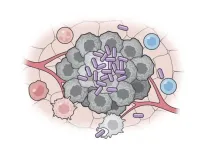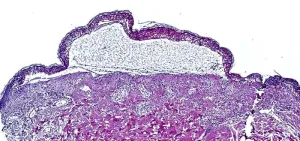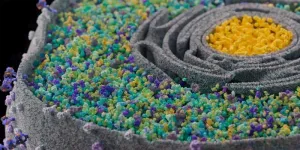Columbia researchers have engineered probiotic bacteria that educate the immune system to destroy cancer cells, opening the door for a new class of cancer vaccines that take advantage of bacteria’s natural tumor-targeting properties. These microbial cancer vaccines can be personalized to attack each individual’s primary tumor and metastases, and may even prevent future recurrences.
In studies using mouse models of advanced colorectal cancer and melanoma, the bacterial vaccine supercharged the immune system to suppress the growth of – or in many cases eliminate – primary and metastatic cancers. All while leaving healthy parts of the body alone.
The findings were published Oct. 16 in Nature.
The bacterial vaccine proved to be particularly more efficacious than peptide-based therapeutic cancer vaccines that have been used in numerous previous cancer clinical trials.
“The important advantage of our system is its unique ability to coordinately restructure and activate all arms of the immune system to induce a productive antitumor immune response. We believe this is why the system works so well in advanced solid tumor models which have been particularly difficult to treat with other immunotherapies,” says Andrew Redenti, an MD/PhD student at Columbia University’s Vagelos College of Physicians and Surgeons who helped lead the study.
“The net effect is that the bacterial vaccine is able to control or eliminate the growth of advanced primary or metastatic tumors and extend survival in mouse models,” says Jongwon Im, a PhD student at Columbia University who helped lead bacterial engineering aspects of the study.
The bacterial vaccine is personalized for each tumor. “Every cancer is unique – tumor cells harbor distinct genetic mutations that distinguish them from normal healthy cells. By programming bacteria that direct the immune system to target these cancer-specific mutations, we can engineer more effective therapies that stimulate a patient’s own immune system to detect and kill their cancer cells,” says Nicholas Arpaia, PhD, Associate Professor of Microbiology & Immunology in the Columbia University’s Vagelos College of Physicians and Surgeons who directed the research with Tal Danino, PhD, Associate Professor of Biomedical Engineering at Columbia’s School of Engineering.
“As we continue to integrate additional safety optimizations through further genetic programming, we are getting closer to the point of testing this therapy in patients,” he adds.
Bacteria as cancer treatment
Bacteria have been utilized in the treatment of cancer since the late 19th century, when Dr. William Coley, who was a surgeon at New York Hospital, observed tumor regression in a subset of patients with inoperable tumors injected with bacteria. Bacteria are still employed as a therapeutic today in patients with early-stage bladder cancer. Researchers now know that some bacteria can naturally migrate to and colonize tumors, where they can thrive in the often oxygen-deprived environment and locally provoke an immune response.
But used this way, bacteria do not usually precisely control or direct the immune response to attack the cancer. “These qualities alone don’t typically give bacteria enough power to stimulate immune responses capable of destroying a tumor, but they’re a good starting point for building a new domain of cancer therapeutics,” says Nicholas Arpaia, PhD.
Inciting multiple parts of the immune system, safely
The new system starts with a probiotic strain of E. coli bacteria. The researchers then made multiple genetic modifications to precisely control the way in which the bacteria interact with and educate the immune system to induce tumor killing.
The engineered bacteria encode protein targets – called neoantigens – that are specific to the cancer being treated. These bacterially-delivered neoantigens train the immune system to target and attack cancer cells that express the same proteins. Neoantigens are used as tumor targets so that normal cells, which lack these cancer-marking proteins, are left alone. Due to the nature of the bacterial system and additional genetic modifications engineered by the scientists, these bacterial cancer therapies also simultaneously overcome immunosuppressive mechanisms tumors use to block the immune system.
These genetic modifications are also designed to block the bacteria’s innate ability to evade immune attacks against themselves. As a safety measure, this means the engineered bacteria can be easily recognized and eliminated by the immune system and are quickly cleared from the body if they do not find the tumor.
When tested in mice, the researchers found that these intricately programmed bacterial cancer vaccines recruit a wide array of immune cells that attack tumor cells, all the while preventing responses that would normally suppress tumor-directed immune attacks.
The bacterial vaccine also reduced the growth of cancer when administered to mice before they developed tumors, and prevented regrowth of the same tumors in mice that had been cured, suggesting the vaccine may have the ability to prevent cancer from returning in patients who’ve experienced remission.
Personalization
In people, the first step in creating these microbial vaccines would be to sequence a patient’s cancer and identify its unique neoantigens using bioinformatics. Next, the bacteria would be engineered to produce large quantities of the identified neoantigens, as well as other immunomodulatory factors. When infused into the patient whose tumors are to be treated, the bacteria would head to the tumors, make themselves at home, and steadily produce and deliver their payload of engineered “medicines.”
Once activated by the bacterial vaccine, the immune system would be prompted to eliminate cancer cells that have spread throughout the body and prevent further metastatic development.
Since each tumor has its own set of neoantigens, the immunotherapy will be custom-made for each patient. “The time to treatment will first depend on how long it takes to sequence the tumor. Then we just need to make the bacterial strains, which can be quite fast. Bacteria can be simpler to manufacture than some other vaccine platforms,” Danino says.
The bacteria are also designed to counteract cancer’s ability to rapidly mutate and evade treatment. “Because our platform allows us to deliver so many different neoantigens, it theoretically becomes difficult for tumor cells to lose all those targets at once and avoid the immune response,” says Arpaia.
The researchers think their approach may succeed where earlier cancer vaccines have not. In the latter, while immune responses against tumor neoantigens may be induced, direct modulation of the immunosuppressive tumor environment is not accomplished to such a degree.
Arpaia adds, “Bacteria allow delivery of a higher concentration of drugs than can be tolerated when these compounds are delivered systemically throughout the entire body. Here, we can confine delivery directly to the tumor and locally modulate how we’re stimulating the immune system.”
More information
The study is titled, “Probiotic neoantigen delivery vectors for precision cancer immunotherapy.”
All authors: Andrew Redenti, Jongwon Im, Benjamin Redenti, Fangda Li, Mathieu Rouanne, Zeren Sheng, William Sun, Candice R. Gurbatri, Shunyu Huang, Meghna Komaranchath, YoungUk Jang, Jaeseung Hahn, Edward R. Ballister, Rosa L. Vincent, Ana Vardoshivilli, Tal Danino, and Nicholas Arpaia (all at Columbia).
The research was funded by grants from the National Institutes of Health (R01CA249160, R01CA259634, U01CA247573, and T32GM145766) and the Searle Scholars Program, and by a Roy and Diana Vagelos Precision Medicine Pilot Grant.
Andrew Redenti, Jongwon Im, Tal Danino, and Nicholas Arpaia have filed a provisional patent application with the US Patent and Trademark Office related to this work.
END






